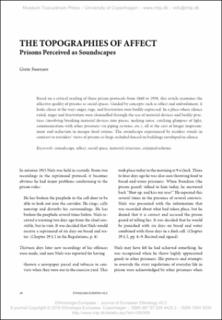| dc.description.abstract | Based on a critical reading of three prison protocols from 1860 to 1930, this article examines the affective quality of prisons as social spaces. Guided by concepts such as affect and embodiment, it looks closer at the ways anger, rage, and frustration were bodily expressed. In a place where silence ruled, anger and frustration were channelled through the use of material devices and bodily prac tices (involving breaking material devices into pieces, making noise, catching glimpses of light, communication with other prisoners via piping systems, etc.), all at the cost of longer imprison ment and reduction in meagre food rations. The soundscape experienced by insiders stands in contrast to outsiders’ views of prisons as large secluded fenced-in buildings enveloped in silence. | en_US |
